capslocked
Forum Veteran
- Joined
- Apr 14, 2015
- Posts
- 2,126
- Reaction
- 771
- Points
- 1,000
Take a trip down memory lane with this list of beloved classic Filipino
 products that have met untimely deaths:
products that have met untimely deaths:
1. Diana Margarine.
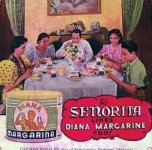
Advertisement of Diana Margarine from a 1940 Literary Song-Movie Magazine. Source: Dennis Villegas via WikiPilipinas.
Diana Margarine became popular in the Philippines between the 1930’s and 1940’s. Similar to Star Margarine, this product was sold in cans and did not require refrigeration. It was manufactured in Manila by Dy Buncio & Co., Inc.
In the product endorsement shown above, pre-war movie star Carmen Rosales (second from right) is referred to as the Señorita, the same name of her hit movie produced by Sampaguita Pictures and directed by Dr. Gregorio Fernandez.
Sitting next to the young Rosales were (from left) Gloria Del Mundo, Rosa Aguirre, Miguel Anzures (assistant production manager), and Narding Anzures.
Narding, son of Rosa Aguirre and Miguel Anzures, was a popular child actor who would later be convicted of murder for killing actress Lilian Velez and her housemaid in 1948.
2. Waling-Waling Face Powder.
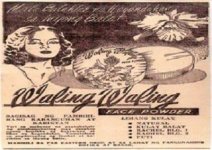
Via philSTAR.com
Popular in the 1940’s, Waling-Waling face powder was advertised as “sagisag ng pambihirang kabanguhan at kariktan” and promised to bring “mala bulaklak na kagandahan” to its consumers.
Waling Waling was popular among the masses, just like Gloria and Madame X cosmetics. Most products under these brands were actually imported from China , repacked here, and were given local names.
, repacked here, and were given local names.
On the other hand, Spanish and American brands were more popular among the affluent. They include Camay and Gloco from the US as well as Heno de Pravia and Bella Aurora from Spain.
3. Halili Beer.
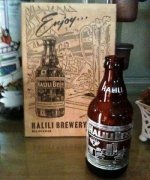
Source: Photos of Philippines, My Philippines Facebook Page/dayviewmusic.sulit.com.ph
Long before San Miguel Corporation gained monopoly of the country’s beer industry, there was Halili Beer that gave the former a run for its money.
Popular in the 1960’s, Halili Beer was manufactured by the F.F. Halili Enterprises, a company established by former Bulacan Governor Fortunato Halili. The company, whose brewery was built along Balintawak in Quezon City, also owned other products and business ventures including Mission Beverages, Goody Rootbeer and the Halili Transit.
Depending on who you ask, Halili beer and beverages fizzled out either because of a strategic acquisition or lack of leadership. It is said that when Gov. Halili was afflicted with infantile paralysis, no one from his sons took over the business, hence the death of the brand. Another version tells about San Miguel Brewery being threatened by Halili Beer, leading the former to buy out stocks of the latter.
Whatever the real story was, it ended in favor of San Miguel who would eventually regain monopoly of the local beer market.
4. Bataan Matamis *********.
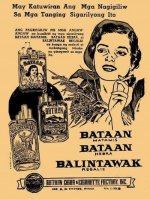
Via Sylvia Amante/Pinterest
Patronized by the masses during the 1940’s, Bataan Matamis was a locally-made ********* sold at a cheaper price. It was manufactured by Bataan Cigar & ********* Factory in Binondo during an era when ******* was still perceived as acceptable, cool, and refreshing.
Unlike other brands of *********, Bataan Matamis had no filter so smokers would inhale, puff, and literally spit out loose *******. Aside from Bataan Matamis, the company also manufactured other variants such as Bataan Hebra, Bataan Hebra Blanco, and Balintawak Regaliz–all of which were heavily advertised in local magazines and newspapers.
5. Sison’s Ice Drops.
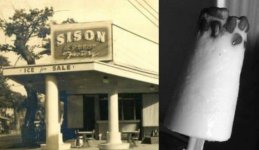
Photo credits: M.R. Gaerlan Collection/pinoyinoz.phc.onl/#forbidden#
Sison was a local manufacturer of ice drops–those delectable alternative to dirty ice cream or expensive snacks sold by Selecta and Magnolia.
Famous for its all-Filipino flavors such as mongo, buko, keso and pinipig, Sison’s ice drops were produced in a factory located at 415-417, 419 Trabajo and 540 Verdad, Sampaloc, Manila.
Before the factory closed down for good, its products were well-loved by kids and adults alike. Mongo and buko flavors were the most popular flavors, and people loved Sison’s ice drops for their delicious but not too overwhelming taste. In fact, the ice drops resemble icicles more–they had rich flavoring yet small amount of milk.
6. Royal Lem-O-Lime Soft Drink.
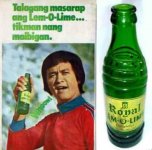
An old Royal Lem-O-Lime Advertisement Soft Drink from the 1970s, starring the late Ramon Zamora (left) and a 1970s Royal Lem-O-Lime bottle (right). Source: WikiPilipinas/You do not have permission to view the full content of this post. Log in or register now.
Royal Lem-O-Lime is a discontinued soft drink manufactured by Royal Tru. It was a cheap citrus flavored soda that became popular from the 1960’s until 1970’s.
Royal Tru became famous for its fruit-flavored soft drinks such as Royal Tru-Orange, Royal Tru-Lemon, Royal Tru-Dalandan, and Royal Tru-Orange Light. Aside from Lem-O-Lime, other products that went into extinction were Royal Ginger Ale, Royal Tonic Water, and Royal Soda Water.
Royal Tru was first introduced by the San Miguel Brewery in 1922. Five years later, San Miguel became a franchisee of Coca-Cola. Both the Royal Tru beverages and the Coca-Cola franchise would eventually combine to become Coca-Cola Bottlers Philippines, Inc. (CCBPI). Then, in 2007, San Miguel finally sold its entire share of CCBPI (including Royal Tru) to the Coca-Cola Company.
7. ‘Ang Tibay’ Shoes.
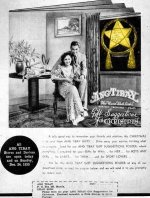
Source: Filipinas Heritage Library/The Sunday Tribune Magazine, December 17, 1939, p.37
Known for its durability, ‘Ang Tibay’ shoes definitely lived up to its famous tagline: The Wear That Lasts. From the 1900’s up to the 1950’s, ‘Ang Tibay’ was almost an indomitable brand of leather footwear, pleasing both locals and foreigners alike.
Just like any great enterprise, ‘Ang Tibay’ also had a humble origin. It’s founder, Toribio Teodoro, was born to poor parents and didn’t even complete elementary education. At a young age, he started working in a cigar factory before he switched to slipper making at the age of 20. It was during this time when the idea of starting a business came to his mind.
In 1910, he opened his first shop on Rizal Avenue with the help of his friend and business partner, Juan Katindig. The two eventually parted ways, leaving Teodoro with no choice but to start “Ang Tibay Footwear Factory” on his own. In the span of 10 years, his company gradually emerged as one of the biggest enterprises in the country, earning him the title “Manila’s Slipper King.”
During the late 1920’s, Teodoro ventured into shoe making. This decision prompted him to hire more employees and build a larger factory in Grace Park in Caloocan. The Art Deco style factory was one of the most modern factories in the country as well as in Asia.
The brand continued to soar until the 1950’s and 1960’s when the popularity of ‘Ang Tibay’ shoes slowly faded.
8. Serg’s Chocolates.
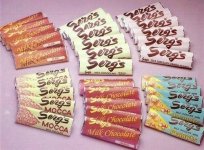
Photo credit: Serg’s Chocolates Official Facebook Page.
The name “Serg’s Chocolates” usually conjure up images of carefree childhood–those times when we all had the luxury to eat a box of chocolates without worrying about tooth decay.
Established in 1954 by Anton Goquiolay, Serg’s Products Inc. offered products such as chocolate bars, breakfast cocoa, candies, and instant coffee. The company was named after Goquiolay’s son, Sergio.
Serg’s was a force to be reckoned with from the 1950’s and well into the 1970’s. Its operation was temporarily halted by the martial law era during which the Goquiolay family migrated to the United States. The company later became part of the Asset Privatization program of the government.
In the early ’90s, Sergio Goquiolay, then already a professor in the US, decided to return to the country and revive their family business. The plan initially went well, with Serg’s even gearing up to export its products to other Asian countries. But all hell broke loose when the 1997 Asian Crisis struck the Philippines. Instead of expanding, Serg’s faced massive debts which were made even worse by labor disputes within the factory.
The beloved chocolate factory filed for bankruptcy in 2001. There was a recent campaign to revive Serg’s chocolates, but no official statement has been released yet to confirm whether the local brand is coming back for good.
9. Elpo Rubber Shoes.
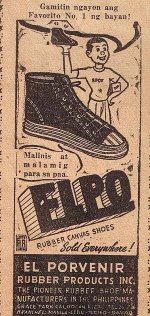
Source: WikiPilipinas/Daigdig Magazine, Manila: Palimbagang Tagumpay, 16 December 1947
If ‘Ang Tibay’ was known for its durable leather footwear, Elpo was the local king of rubber shoes. The latter was the brainchild of Don Tomas C. Geronimo who opened El Porvenir Rubber Products Inc. in 1933. The said company was the pioneer rubber shoe manufacturer in the Philippines.
The company’s flagship product, the Elpo rubber shoes, was the Philippines’ answer to Converse during the 1940’s and well into the 1960’s. The term “Elpo” was a contraction of El Porvenir which means “the future.”
10. Radiowealth Television.
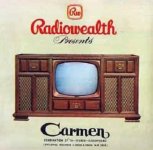
Source: WikiPilipinas/Weekly Women’s Magazine, July 23, 1965
Radiowealth may not ring a bell to the younger generation, but it was actually a pioneer company in the local television industry.
It all started when You do not have permission to view the full content of this post. Log in or register now.–also credited for creating the first Filipino car called Sakbayan–earned the right to distribute Motorola radio and TV set in 1946. By 1955, his company, Radiowealth, Inc., began manufacturing its own television sets made from imported electronic parts. Theirs were more affordable so many Filipino families had the chance to own this appliance.
In the following years, Radiowealth continued blazing the trail. In 1966, Radiowealth, Inc. started producing 19-, 21- and 25-inch models of TV sets. The Philippines also became the third country to manufacture color TV sets, thanks to Radiowealth.
11. Magnolia Choco-Vim.
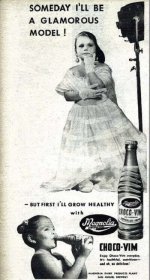
Via Magnolia Choco-Vim Facebook Page
Magnolia Choco-Vim was the precursor of today’s Chocolait. For the baby boomers, this was the ideal comfort drink. It had a rich, creamy, milk chocolate-y taste loved by all kids.
First manufactured in the 1960’s, Choco-Vim came in bottles of different shapes: square, round, and squat. Similar to your typical bottle of Coca-Cola, a single Choco-Vim only costs 35 to 50 centavos back then. You could serve it cold or even frozen–an ideal treat during a hot summer.
Faced by intense competition with other chocolate drink brands such as Milo in the ’70s and ’80s, Choco-Vim was eventually re-branded as Chocolait.
12. Presto Funwich.
You do not have permission to view the full content of this post. Log in or register now.
Photo credit: pale spectre via Flickr
Presto Funwich was the ultimate chocolate snack for those who grew up in the ’90s. It was so delectable that some say DQ’s own version of ice cream sandwich is no match to this classic and now-defunct brand.
Produced by Consolidated Foods Corporation (now merged with Universal Robina Corporation), Presto Funwich was priced at less than 20 pesos and came in two mouth-watering flavors: Vanilla and dark chocolate. It is best remembered for its luscious ice cream filling complemented by two dark chocolate wafer biscuits.
13. Whammo’s.

Whammo’s is another nostalgic food from the ’90s that suddenly went extinct. A chocolate snack cake with a rich creamy filling, it was introduced in the country in 1993 and was touted as the ‘first extended-life, snack cake.’
Whammo’s was manufactured by Filia Foods Inc., a company owned by Trillana-De Ocampo families, the same people behind memorable products such as Coney Island ice cream as well as today’s Go Nuts Donuts.
14. Magnolia Ice Cream – Chico Flavor.

Via video48.phc.onl/#forbidden#
Magnolia, a Filipino ice cream brand owned by San Miguel Corporation, unveiled the “Flavor of the Month” in 1954. As the name suggests, it was a way for Magnolia to introduce new ice cream flavor every month.
The monthly offerings included classic favorites such as Choco Pretzel and Banana Split as well as tropical fruits such as Chico (which became the Flavor of the Month for December).
In 1983, Magnolia released another offering, this time using Philippine fruits and delicacies. Dubbed as “Sorbetes,” the special line of flavors include Ube Macapuno, Fruit Salad, and Halo-Halo Fiesta among others.
1. Diana Margarine.

Advertisement of Diana Margarine from a 1940 Literary Song-Movie Magazine. Source: Dennis Villegas via WikiPilipinas.
Diana Margarine became popular in the Philippines between the 1930’s and 1940’s. Similar to Star Margarine, this product was sold in cans and did not require refrigeration. It was manufactured in Manila by Dy Buncio & Co., Inc.
In the product endorsement shown above, pre-war movie star Carmen Rosales (second from right) is referred to as the Señorita, the same name of her hit movie produced by Sampaguita Pictures and directed by Dr. Gregorio Fernandez.
Sitting next to the young Rosales were (from left) Gloria Del Mundo, Rosa Aguirre, Miguel Anzures (assistant production manager), and Narding Anzures.
Narding, son of Rosa Aguirre and Miguel Anzures, was a popular child actor who would later be convicted of murder for killing actress Lilian Velez and her housemaid in 1948.
2. Waling-Waling Face Powder.

Via philSTAR.com
Popular in the 1940’s, Waling-Waling face powder was advertised as “sagisag ng pambihirang kabanguhan at kariktan” and promised to bring “mala bulaklak na kagandahan” to its consumers.
Waling Waling was popular among the masses, just like Gloria and Madame X cosmetics. Most products under these brands were actually imported from China
On the other hand, Spanish and American brands were more popular among the affluent. They include Camay and Gloco from the US as well as Heno de Pravia and Bella Aurora from Spain.
3. Halili Beer.

Source: Photos of Philippines, My Philippines Facebook Page/dayviewmusic.sulit.com.ph
Long before San Miguel Corporation gained monopoly of the country’s beer industry, there was Halili Beer that gave the former a run for its money.
Popular in the 1960’s, Halili Beer was manufactured by the F.F. Halili Enterprises, a company established by former Bulacan Governor Fortunato Halili. The company, whose brewery was built along Balintawak in Quezon City, also owned other products and business ventures including Mission Beverages, Goody Rootbeer and the Halili Transit.
Depending on who you ask, Halili beer and beverages fizzled out either because of a strategic acquisition or lack of leadership. It is said that when Gov. Halili was afflicted with infantile paralysis, no one from his sons took over the business, hence the death of the brand. Another version tells about San Miguel Brewery being threatened by Halili Beer, leading the former to buy out stocks of the latter.
Whatever the real story was, it ended in favor of San Miguel who would eventually regain monopoly of the local beer market.
4. Bataan Matamis *********.

Via Sylvia Amante/Pinterest
Patronized by the masses during the 1940’s, Bataan Matamis was a locally-made ********* sold at a cheaper price. It was manufactured by Bataan Cigar & ********* Factory in Binondo during an era when ******* was still perceived as acceptable, cool, and refreshing.
Unlike other brands of *********, Bataan Matamis had no filter so smokers would inhale, puff, and literally spit out loose *******. Aside from Bataan Matamis, the company also manufactured other variants such as Bataan Hebra, Bataan Hebra Blanco, and Balintawak Regaliz–all of which were heavily advertised in local magazines and newspapers.
5. Sison’s Ice Drops.

Photo credits: M.R. Gaerlan Collection/pinoyinoz.phc.onl/#forbidden#
Sison was a local manufacturer of ice drops–those delectable alternative to dirty ice cream or expensive snacks sold by Selecta and Magnolia.
Famous for its all-Filipino flavors such as mongo, buko, keso and pinipig, Sison’s ice drops were produced in a factory located at 415-417, 419 Trabajo and 540 Verdad, Sampaloc, Manila.
Before the factory closed down for good, its products were well-loved by kids and adults alike. Mongo and buko flavors were the most popular flavors, and people loved Sison’s ice drops for their delicious but not too overwhelming taste. In fact, the ice drops resemble icicles more–they had rich flavoring yet small amount of milk.
6. Royal Lem-O-Lime Soft Drink.

An old Royal Lem-O-Lime Advertisement Soft Drink from the 1970s, starring the late Ramon Zamora (left) and a 1970s Royal Lem-O-Lime bottle (right). Source: WikiPilipinas/You do not have permission to view the full content of this post. Log in or register now.
Royal Lem-O-Lime is a discontinued soft drink manufactured by Royal Tru. It was a cheap citrus flavored soda that became popular from the 1960’s until 1970’s.
Royal Tru became famous for its fruit-flavored soft drinks such as Royal Tru-Orange, Royal Tru-Lemon, Royal Tru-Dalandan, and Royal Tru-Orange Light. Aside from Lem-O-Lime, other products that went into extinction were Royal Ginger Ale, Royal Tonic Water, and Royal Soda Water.
Royal Tru was first introduced by the San Miguel Brewery in 1922. Five years later, San Miguel became a franchisee of Coca-Cola. Both the Royal Tru beverages and the Coca-Cola franchise would eventually combine to become Coca-Cola Bottlers Philippines, Inc. (CCBPI). Then, in 2007, San Miguel finally sold its entire share of CCBPI (including Royal Tru) to the Coca-Cola Company.
7. ‘Ang Tibay’ Shoes.

Source: Filipinas Heritage Library/The Sunday Tribune Magazine, December 17, 1939, p.37
Known for its durability, ‘Ang Tibay’ shoes definitely lived up to its famous tagline: The Wear That Lasts. From the 1900’s up to the 1950’s, ‘Ang Tibay’ was almost an indomitable brand of leather footwear, pleasing both locals and foreigners alike.
Just like any great enterprise, ‘Ang Tibay’ also had a humble origin. It’s founder, Toribio Teodoro, was born to poor parents and didn’t even complete elementary education. At a young age, he started working in a cigar factory before he switched to slipper making at the age of 20. It was during this time when the idea of starting a business came to his mind.
In 1910, he opened his first shop on Rizal Avenue with the help of his friend and business partner, Juan Katindig. The two eventually parted ways, leaving Teodoro with no choice but to start “Ang Tibay Footwear Factory” on his own. In the span of 10 years, his company gradually emerged as one of the biggest enterprises in the country, earning him the title “Manila’s Slipper King.”
During the late 1920’s, Teodoro ventured into shoe making. This decision prompted him to hire more employees and build a larger factory in Grace Park in Caloocan. The Art Deco style factory was one of the most modern factories in the country as well as in Asia.
The brand continued to soar until the 1950’s and 1960’s when the popularity of ‘Ang Tibay’ shoes slowly faded.
8. Serg’s Chocolates.

Photo credit: Serg’s Chocolates Official Facebook Page.
The name “Serg’s Chocolates” usually conjure up images of carefree childhood–those times when we all had the luxury to eat a box of chocolates without worrying about tooth decay.
Established in 1954 by Anton Goquiolay, Serg’s Products Inc. offered products such as chocolate bars, breakfast cocoa, candies, and instant coffee. The company was named after Goquiolay’s son, Sergio.
Serg’s was a force to be reckoned with from the 1950’s and well into the 1970’s. Its operation was temporarily halted by the martial law era during which the Goquiolay family migrated to the United States. The company later became part of the Asset Privatization program of the government.
In the early ’90s, Sergio Goquiolay, then already a professor in the US, decided to return to the country and revive their family business. The plan initially went well, with Serg’s even gearing up to export its products to other Asian countries. But all hell broke loose when the 1997 Asian Crisis struck the Philippines. Instead of expanding, Serg’s faced massive debts which were made even worse by labor disputes within the factory.
The beloved chocolate factory filed for bankruptcy in 2001. There was a recent campaign to revive Serg’s chocolates, but no official statement has been released yet to confirm whether the local brand is coming back for good.
9. Elpo Rubber Shoes.

Source: WikiPilipinas/Daigdig Magazine, Manila: Palimbagang Tagumpay, 16 December 1947
If ‘Ang Tibay’ was known for its durable leather footwear, Elpo was the local king of rubber shoes. The latter was the brainchild of Don Tomas C. Geronimo who opened El Porvenir Rubber Products Inc. in 1933. The said company was the pioneer rubber shoe manufacturer in the Philippines.
The company’s flagship product, the Elpo rubber shoes, was the Philippines’ answer to Converse during the 1940’s and well into the 1960’s. The term “Elpo” was a contraction of El Porvenir which means “the future.”
10. Radiowealth Television.

Source: WikiPilipinas/Weekly Women’s Magazine, July 23, 1965
Radiowealth may not ring a bell to the younger generation, but it was actually a pioneer company in the local television industry.
It all started when You do not have permission to view the full content of this post. Log in or register now.–also credited for creating the first Filipino car called Sakbayan–earned the right to distribute Motorola radio and TV set in 1946. By 1955, his company, Radiowealth, Inc., began manufacturing its own television sets made from imported electronic parts. Theirs were more affordable so many Filipino families had the chance to own this appliance.
In the following years, Radiowealth continued blazing the trail. In 1966, Radiowealth, Inc. started producing 19-, 21- and 25-inch models of TV sets. The Philippines also became the third country to manufacture color TV sets, thanks to Radiowealth.
11. Magnolia Choco-Vim.

Via Magnolia Choco-Vim Facebook Page
Magnolia Choco-Vim was the precursor of today’s Chocolait. For the baby boomers, this was the ideal comfort drink. It had a rich, creamy, milk chocolate-y taste loved by all kids.
First manufactured in the 1960’s, Choco-Vim came in bottles of different shapes: square, round, and squat. Similar to your typical bottle of Coca-Cola, a single Choco-Vim only costs 35 to 50 centavos back then. You could serve it cold or even frozen–an ideal treat during a hot summer.
Faced by intense competition with other chocolate drink brands such as Milo in the ’70s and ’80s, Choco-Vim was eventually re-branded as Chocolait.
12. Presto Funwich.
You do not have permission to view the full content of this post. Log in or register now.
Photo credit: pale spectre via Flickr
Presto Funwich was the ultimate chocolate snack for those who grew up in the ’90s. It was so delectable that some say DQ’s own version of ice cream sandwich is no match to this classic and now-defunct brand.
Produced by Consolidated Foods Corporation (now merged with Universal Robina Corporation), Presto Funwich was priced at less than 20 pesos and came in two mouth-watering flavors: Vanilla and dark chocolate. It is best remembered for its luscious ice cream filling complemented by two dark chocolate wafer biscuits.
13. Whammo’s.

Whammo’s is another nostalgic food from the ’90s that suddenly went extinct. A chocolate snack cake with a rich creamy filling, it was introduced in the country in 1993 and was touted as the ‘first extended-life, snack cake.’
Whammo’s was manufactured by Filia Foods Inc., a company owned by Trillana-De Ocampo families, the same people behind memorable products such as Coney Island ice cream as well as today’s Go Nuts Donuts.
14. Magnolia Ice Cream – Chico Flavor.

Via video48.phc.onl/#forbidden#
Magnolia, a Filipino ice cream brand owned by San Miguel Corporation, unveiled the “Flavor of the Month” in 1954. As the name suggests, it was a way for Magnolia to introduce new ice cream flavor every month.
The monthly offerings included classic favorites such as Choco Pretzel and Banana Split as well as tropical fruits such as Chico (which became the Flavor of the Month for December).
In 1983, Magnolia released another offering, this time using Philippine fruits and delicacies. Dubbed as “Sorbetes,” the special line of flavors include Ube Macapuno, Fruit Salad, and Halo-Halo Fiesta among others.
Attachments
-
You do not have permission to view the full content of this post. Log in or register now.